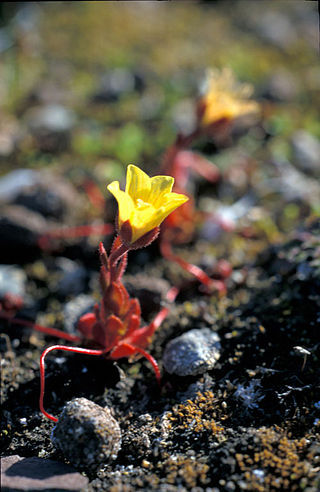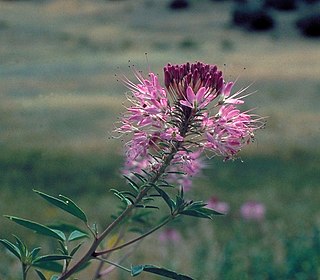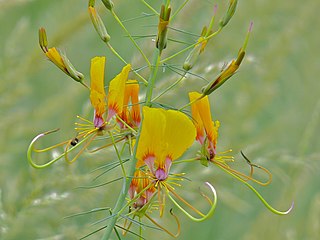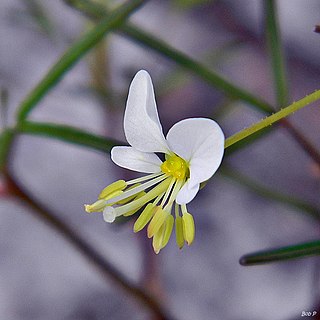
The Brassicales are an order of flowering plants, belonging to the eurosids II group of dicotyledons under the APG II system. One character common to many members of the order is the production of glucosinolate compounds. Most systems of classification have included this order, although sometimes under the name Capparales.

Spider plant is a common name for several plants and may refer to:

Cleomella serrulata, commonly known as Rocky Mountain beeplant/beeweed, stinking-clover, bee spider-flower, skunk weed, Navajo spinach, and guaco, is a species of annual plant in the genus Cleomella. Many species of insects are attracted to it, especially bees, which helps in the pollination of nearby plants. It is native to southern Canada and the western and central United States. The plant has often been used for food, to make dyes for paint, and as a treatment in traditional medicine.

Glenealy is one of the few roads or streets without a suffix in Hong Kong. Located in the Mid-Levels on the Hong Kong Island, Hong Kong, it starts from Ice House Street and goes uphill to Hong Kong Zoological and Botanical Gardens, across Robinson Road and ends at Hornsey Road and Conduit Road.

The Capparaceae, commonly known as the caper family, are a family of plants in the order Brassicales. As currently circumscribed, the family contains 15 genera and about 430 species. The largest genera are Capparis, Morisonia, Maerua, Boscia, and Cadaba.

Cleome is a genus of flowering plants in the family Cleomaceae, commonly known as spider flowers, spider plants, spider weeds, or bee plants. Previously, it had been placed in the family Capparaceae, until DNA studies found the Cleomaceae genera to be more closely related to the Brassicaceae than the Capparaceae. Cleome and clammyweed can sometimes be confused.

Cleome houtteana, commonly known as spider flower, spider plant, pink queen, or grandfather's whiskers, is a species of flowering plant in the genus Cleome of the family Cleomaceae, native to southern South America in Argentina, Paraguay, Uruguay, and southeast Brazil. It has also been introduced to South Asia, including the Haor area of Bangladesh and India.

Glenealy is a village in County Wicklow, Ireland. It is 8 km (5 mi) west of Wicklow Town, on the R752 road. The Dublin–Rosslare railway line also passes through the village. The village is in a civil parish of the same name.

The Cleomaceae are a small family of flowering plants in the order Brassicales, comprising about 220 species in two genera, Cleome and Cleomella. These genera were previously included in the family Capparaceae, but were raised to a distinct family when DNA evidence suggested the genera included in it are more closely related to the Brassicaceae than they are to the Capparaceae. The APG II system allows for Cleomaceae to be included in Brassicaceae. Cleomaceae includes C3, C3–C4, and C4 photosynthesis species.

Cleome gynandra is a species of Cleome that is used as a leaf vegetable. It is known by many common names including Shona cabbage, African cabbage, spiderwisp, cat's whiskers, and stinkweed. It is an annual wildflower native to Africa but has become widespread in many tropical and sub-tropical parts of the world.
Glenealy Hurling Club is a Gaelic Athletic Association club located in the parish of Glenealy and Ashford in County Wicklow, Ireland. The club was founded in 1885 as a football club but switched codes to the game of hurling in the early 1920s.

Cleome rutidosperma, commonly known as fringed spider flower or purple cleome, is a species of flowering plant in the genus Cleome of the family Cleomaceae, native to tropical Africa. This species is an invasive weed throughout most lowland wet tropical areas of Asia and Australia. It is a very common weed of lawns.

Glenea is a genus of longhorn beetles belonging to the family Cerambycidae, subfamily Lamiinae.

Cleome maculata is a species of cleome that is native to southern Africa, where it occurs in sandy soils, especially in rocky habitats, and on slopes. It is a mostly annual plant, which is found in highveld regions of medium rainfall in South Africa, Botswana and Namibia. It is an erect and simple or branching plant, usually less than a foot tall, with sparse leaves. The linear leaflets are three to five compound. Two of the up-curved, mauve flower petals have a yellow mark at their center, which is bordered with dark purple. The long, up-curved stamens are tipped with bluish, knobby anthers. The fruit is a linear capsule. The species is a pioneer plant that may become a weed.

Cleome viscosa, the Asian spiderflower or tick weed is an annual herb that grows up to a meter high. It belongs to the family Cleomaceae. It is considered an invasive species and is widely distributed in warm and humid habitats across the Americas, Africa and Asia, and in Australia. It is commonly found during the rainy season.

Cleome angustifolia, known as golden cleome, yellow cleome or yellow mouse whiskers, is an African species of plant in the Cleomaceae family. It is common along roadsides and in disturbed areas and is eaten as vegetable locally. Swedish naturalist Peter Forsskål described C. angustifolia in 1775. It is one of three species in genus Cleome (the others being C. gynandra and C. oxalidea) that independently acquired the C4 pathway of carbon fixation. A species close to C. angustifolia, Cleome paradoxa, is C3–C4 intermediate.

Cleome spinosa, called the spiny spiderflower, is a species of flowering plant in the genus Cleome. It is native to the New World Tropics, and has been introduced to the United States, tropical Africa, the Indian Subcontinent, Vietnam, New Caledonia, and Korea. It is pollinated by bats.

Polansia tenuifolia is a species of flowering plant in the family Cleomaceae. It grows in Florida. It is known by the common names pineland catchfly and slender-leaf clammyweed. It is synonymous with Aldenella tenuifolia, Cleome aldanella, Cleome tenuifolia, and Jacksonia tenuifolia. It is an annual.
















